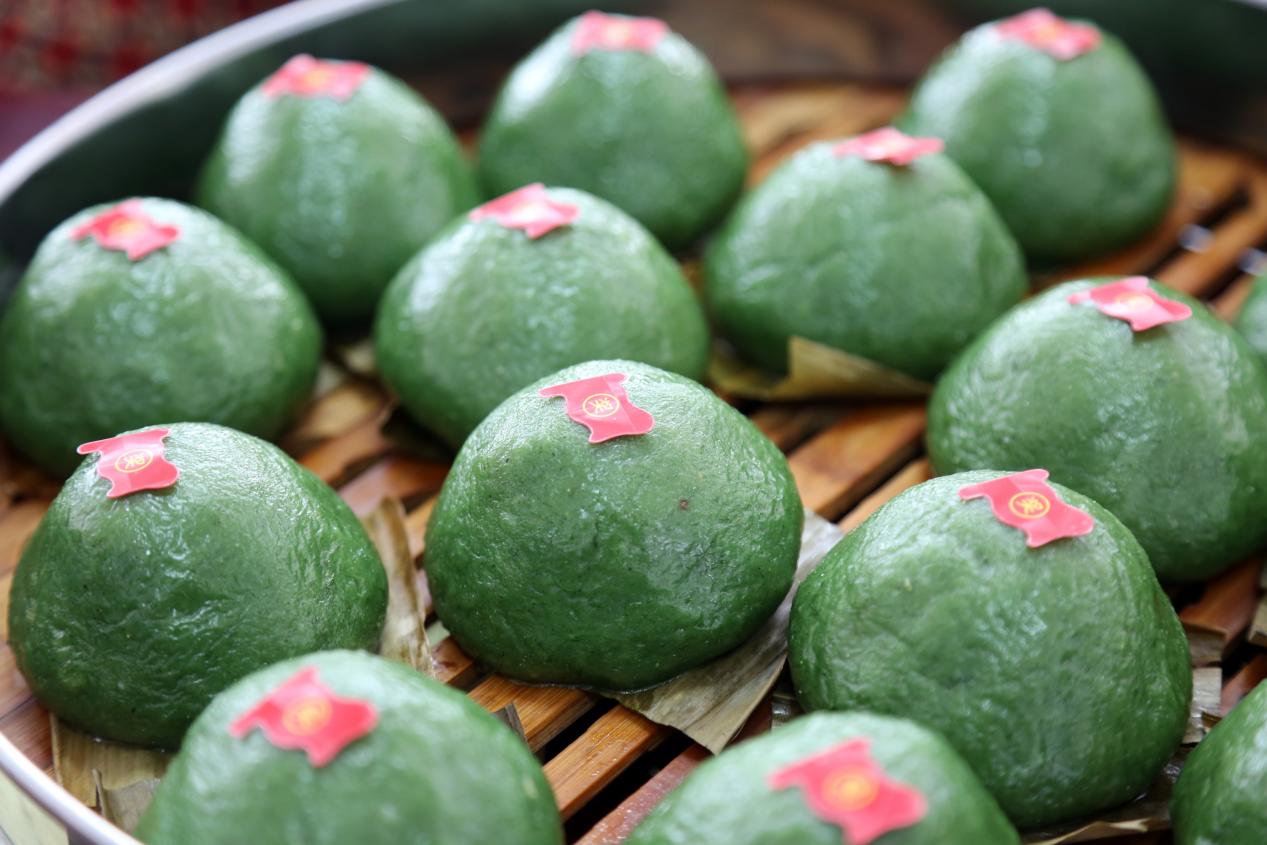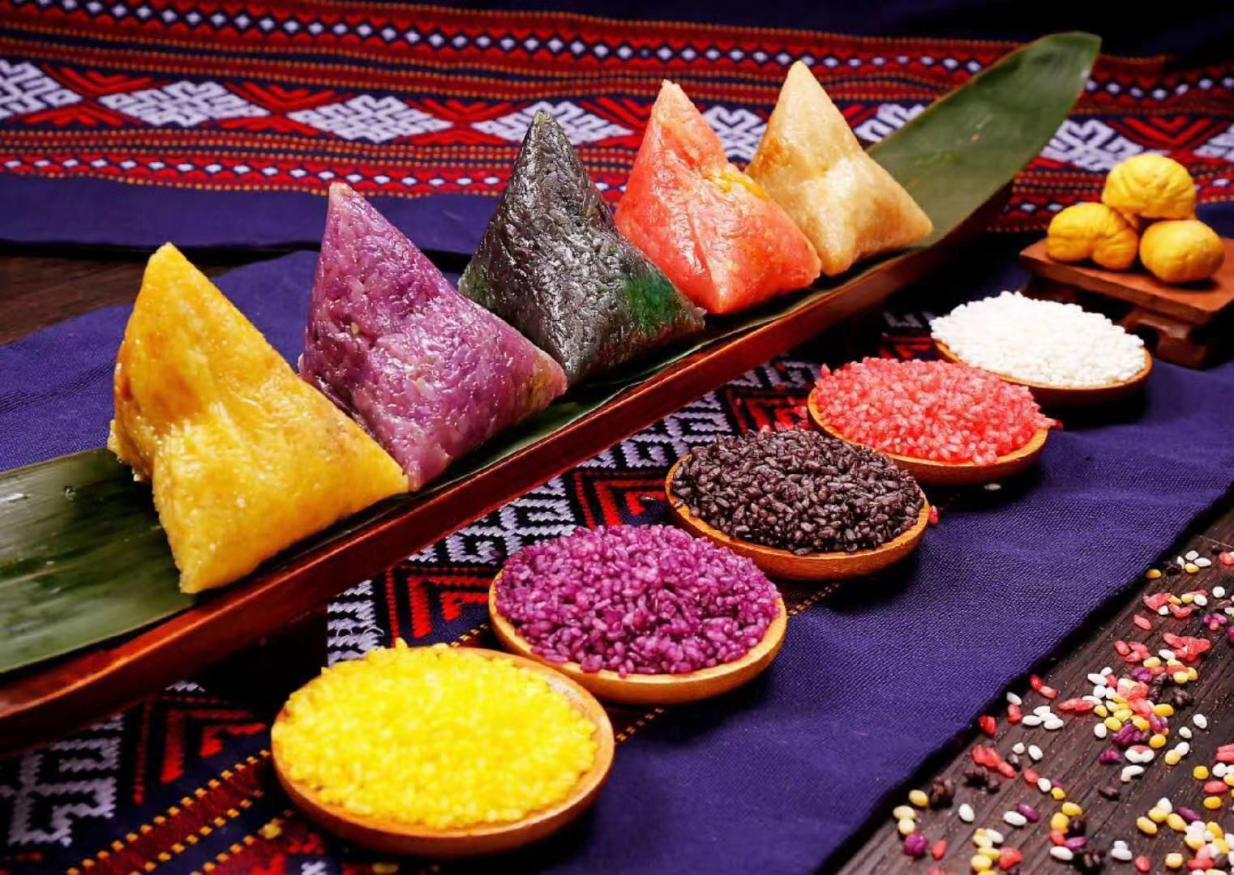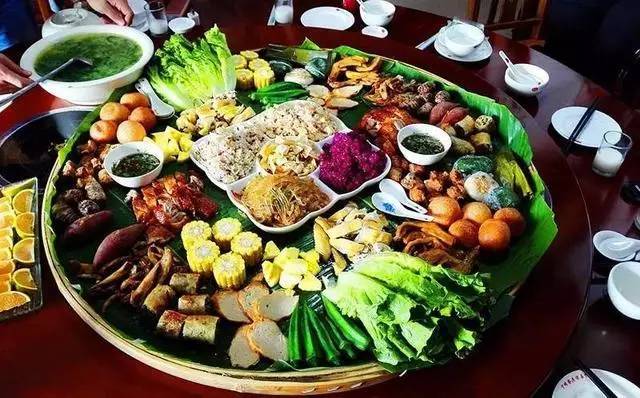

(By Mo Tingting)When you flock to Guangxi, the hometown of Sister Liu Sanjie (the legendary singing fairy), and ask the locals for “the experience should not be missed”, the answer you may hear is the “March 3rd Festival (Sanyuesan Festival)”. Apart from amazing architecture, colorful costumes, and excellent dances and songs, the Sanyuesan celebrations also take on a variety of flavors across Guangxi. Zhuang cuisine also is an eye-opening attraction during the festival. The locals are hospitable. Exquisite dishes such as five-colored glutinous rice, Ciba and dustpan feast will be served to guests and friends from afar.

A feast to keep away from diseases and disasters
The Sanyuesan Festival has its Zhuang version of origin, from a mythical story about an old woman and an injured snake. After being saved by a kind woman, the snake decided to give up its tail to be her son. When the woman passed away on the third day of the third lunar month, the snake son expressed his appreciation by taking his human mother to the summit of the Daming Mountain. Since then, extreme weather such as storms or hail often broke around the Daming Mountain area on March 3rd, which was regarded by Zhuang people as an indication of the snake son coming to see its human mother. Therefore, Zhuang people hailed the old woman as the “Dragon Mother” and thought that Zhuang people living in the Daming Mountain area were genuine “descendants of the dragon”. Nowadays, Zhuang people hold ceremonies and make a feast on this day in memory of the “Dragon Mother” for her kindness, benevolence and maternity, as well as her son for its obedience.
The charm and uniqueness of Guangxi’s March 3rd Festival lie not only in their excellent singing and dancing but also in the ingenuity of local people. Food represents an indispensable part of a traditional festival. Rice and corn constitute their staple food, among which five-colored glutinous rice is a delicacy on festive occasions.

A few days before the celebration, Zhuang girls collect fresh wild flowers and leaves from the mountains to produce natural colors in order to dye glutinous rice. Usually, people would put maple leaves into the cracks of the doors and windows on March 1st and prepare five-colored glutinous rice to worship their ancestors and the “Dragon Mother” on March 3rd. It is said that someone who eats the five-colored glutinous rice can be protected from diseases and disasters.
Zhuang people set up a singing tent in their villages, and serve the five-colored glutinous rice in the tents. People, young and old, sing and dance around the tents, and eat the five-colored glutinous rice together. For Zhuang people, dinner brings the whole family together, during this golden time they can relax totally after a day’s hard work. Hence, it overtakes breakfast and lunch as the most sumptuous one.
Tips: Five-colored glutinous rice: As an irreplaceable offering, it is said that the glutinous rice’s colors derive from the snake son which had five colors on its skin, In memory of it, people dye rice with plants of different colors (usually red, yellow, purple, black and white).
Delicacies to enliven your senses
Widely celebrated by the Zhuang people across Guangxi with various activities, the Sanyuesan Festival is a traditional grand gathering which is bound to be both impressive and thrilling. In addition to five-colored glutinous rice, Ciba (glutinous rice cake), deserves another special mention during the Sanyuesan Festival. The handmade Ciba is made of glutinous rice with sesame or peanuts as the fillings according to preference, and some may be wrapped up in banana leaves. Sometimes, a green plant called mugwort is what brings the color to the delicacy. When steamed for around one hour, a fabulous mixed fragrance will fill the air and seduce you to have a bite. The color and taste embody the features of spring. The soft and sticky balls are also sweet and refreshing if sweetened bean paste is added. Sweet green glutinous rice cakes are jade-green in color, glutinous in taste and sweet in aroma.
The custom of making sweet glutinous rice cakes dates back to 2,000 years ago. Any festival such as Tomb Sweeping Festival, Sanyuesan Festival, and Dragon Boat Festival won’t be complete without it. The round Ciba is a token of reunion and good harvest. It’s glutinous and sticky, embodying the Zhuang people’s attitude on kinship and friendship. It is also a must-have offering at ancestral rituals for Zhuang people to attach much importance in worshiping of ancestors. Instead of making sweet glutinous rice cakes by hands like their mothers or grandmas, young people buy them with a smartphone app or simply queue up at a bakery.
Presumably, food is the best way for us to remember the national characteristics. Another way to enjoy Zhuang cuisine is to have a dustpan feast with local characteristics during the Sanyuesan Festival. When the dishes are served, two Zhuang women in ethnic costumes carry the dishes to the table with a dustpan. On a dustpan, there are various kinds of food, which mainly contains mixed grains, nuts, vegetables and dried fish and so on.

Speaking of the origin of the dustpan feast, it is said that once local Zhuang people go out to work, they would take out their food and share it on a dustpan when they take a break. Here, you can have a funny experience of taking the dustpan as a dish, and making fingers as chopsticks.
Does your mouth water after seeing so much Zhuang cuisine? If you come to Guangxi during the Sanyuesan Festival, don’t forget to taste these folk dishes with unique characteristics.
Tips:The dustpan is a kind of article for daily use of the Zhuang people, and foods are usually served on the banana leaf in the dustpan. The dustpan feast symbolizes reunion, so it is also the first choice for gathering among neighbors and relatives.
Source: China-ASEAN Panorama
桂ICP备14000177号 Copyright@2006-2013 Guangxi China-ASEAN Panorama Magazine Agency Co., Ltd. All Rights Reserved